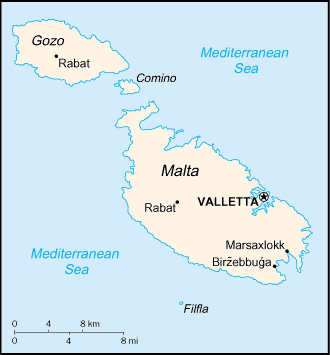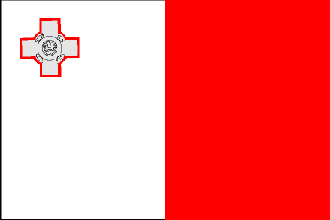
|
Malta
Background:
Great Britain formally acquired possession of Malta in 1814. The
island staunchly supported the UK through both World Wars and remained in the
Commonwealth when it became independent in 1964. A decade later Malta became a
republic. Over the last 15 years, the island has become a major freight
transshipment point, financial center, and tourist destination. It is an
official candidate for EU membership.
Location:
Southern Europe, islands in the Mediterranean Sea, south of Sicily (Italy).
Area: Total: 316 sq km.
Area - comparative: Slightly less than twice the size of Washington, DC.
Coastline: 196.8 km (does not include 56.01 km for the island of Gozo).
Climate and Terrain:
Climate: Mediterranean with mild, rainy winters and hot, dry summers.
Terrain: Mostly low, rocky, flat to dissected plains; many coastal cliffs.
Elevation extremes: Lowest point: Mediterranean Sea 0 m highest point:
Ta'Dmejrek 253 m (near Dingli).
Natural resources: Limestone, salt, arable land.
Land use: Arable land: 32%, forests and woodland: 4%.
People:
Population: 394,583.
Ethnic groups: Maltese (descendants of ancient Carthaginians and Phoenicians,
with strong elements of Italian and other Mediterranean stock).
Religions: Roman Catholic 91%.
Languages: Maltese (official), English (official).
Government:
Government type: Republic.
Capital: Valletta.
Economy overview:
Major resources are limestone, a favorable geographic
location, and a productive labor force. Malta produces only about 20% of its
food needs, has limited freshwater supplies, and has no domestic energy
sources. The economy is dependent on foreign trade, manufacturing (especially
electronics and textiles), and tourism. Malta is privatizing state-controlled
firms and liberalizing markets in order to prepare for membership in the
European Union. However, the island is divided politically over the question of
joining the EU. The sizable budget deficit remains a key concern.
Labor force: 145,901.
Labor force - by occupation: Industry 24%, services 71%, agriculture 5%.
Agriculture - products: Potatoes, cauliflower, grapes, wheat, barley, tomatoes,
citrus, cut flowers, green peppers; pork, milk, poultry, eggs.
Statistics:
Telephones - main lines in use: 187.
Telephones - mobile cellular: 17,691.
Radio broadcast stations: AM 1, FM 18.
Radios: 255,000.
Television broadcast stations: 6.
Televisions: 280,000.
Internet users: 40,000 (2000)
Highways: Total: 1,742 km, paved: 1,677 km, unpaved: 65 km.
Airports - with paved runways: 1.
Return to Visiting Locations
|

